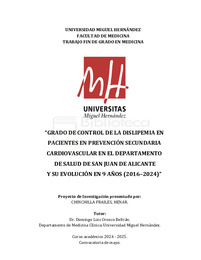Resumen :
Introducción – Las guías europeas establecen un objetivo de LDL-colesterol (c-LDL) < 55
mg/dL tras un evento coronario, pero su grado de cumplimiento y efecto sobre la supervivencia
siguen poco definidos. Este estudio describe el control lipídico al año del alta, su evolución
2016-2024 y su relación con la mortalidad en el Departamento de Salud Universitario Alicante-
Sant Joan (DSUASJ).
Material y métodos – Cohorte retrospectiva de todos los primeros ingresos por cardiopatía
isquémica (CIE-10) entre 2016-2024, excluyendo traslados y reingresos. Se recogieron
variables demográficas, servicio de ingreso, perfil lipídico a 12 meses y mortalidad
intrahospitalaria y a nueve años. El análisis incluyó estadística descriptiva, comparaciones
bivariantes y modelos multivariantes.
Resultados – Se analizaron 5361 pacientes (72 % varones; 58 % con 70-90 años). La tasa de
ingresos cayó un 54 % (41,7 → 19,1/10 000 hab.), mayor en varones (-57 %) que en mujeres (-
45 %). El 24,2 % no tenía analítica al año y, de ellos, el 5,2 % falleció sin control lipídico. Solo el
28,9 % alcanzó c-LDL < 55 mg/dL; el 52,4 % se mantuvo< 70 mg/dL, con peor control en
mujeres (56 % vs 42 %) y en mayores (16,5 vs 29,5%; p=,001). La mortalidad intrahospitalaria
fue del 6,3 % (7,9 % mujeres; 5,6 % varones) y la de 9 años del 31,8 %, aumentando con la edad.
En el modelo ajustado, la edad (OR 1,09/año; IC 95 % 1,081-1,100) y el ingreso fuera de
Cardiología (OR 2,13; IC 95 % 1,81-2,49) fueron predictores independientes de mortalidad,
mientras que el perfil lipídico no conservó significación.
Conclusiones – El control de la dislipemia tras un evento coronario sigue lejos de las
recomendaciones y sin mejoras en la última década. Mujeres y pacientes de mayor edad
concentran el peor control de c-LDL y la mayor mortalidad, lo que exige programas de
seguimiento lipídico más rigurosos y circuitos asistenciales específicos en prevención
secundaria.
Introduction – European guidelines recommend lowering LDL-cholesterol (LDL-C) to < 55
mg/dL after a coronary event, but it is unclear how often this goal is achieved or how it affects
long-term survival. We assessed one-year lipid control, its trend from 2016 to 2024, and its
association with mortality in the Alicante–Sant Joan health district.
Methods – This retrospective cohort included every first hospital admission for ischemic heart
disease (ICD-10) between 2016 and 2024, excluding transfers and readmissions. Electronic
records provided age, sex, admitting ward, 12-month lipid tests, in-hospital deaths, and nineyear
all-cause mortality. Descriptive statistics, bivariate tests, and multivariable models were
applied.
Results – We analysed 5361 patients (72 % men; 58 % aged 70–90 years). Admission rates fell
54 % (41.7 → 19.1 per 10 000), with a steeper drop in men (-57 %) than women (-45 %). A lipid
panel was absent in 24.2 % of survivors, and 5.2 % of these patients died within the year. Only
28,9% reached LDL-C < 55 mg/dL, while 52,4% remained <70 mg/dL; women had poorer
control (58% vs 42% in men) and the same happened with the eldest. (16,5 vs 29,5%; p=,001).
In-hospital mortality was 6.3 % (7.9 % women; 5.6 % men), and nine-year mortality 31.8 %,
rising steadily with age. After adjustment, each additional year of age increased the odds of
death (OR 1.09/year; IC 95 % 1,081-1,100)), and admission outside Cardiology doubled it (OR
2.13; IC 95 % 1,81-2,49). Baseline LDL-C was not an independent predictor.
Conclusions – LDL-C control after a coronary admission remains low and has not improved
over the past decade. Women and older patients show the worst lipid profiles and the highest
mortality, indicating a need for tighter follow-up and more intensive secondary-prevention
strategies in these groups.
|
 La licencia se describe como: Atribución-NonComercial-NoDerivada 4.0 Internacional.
La licencia se describe como: Atribución-NonComercial-NoDerivada 4.0 Internacional.
.png)
